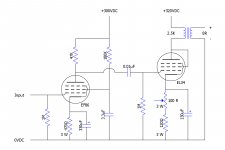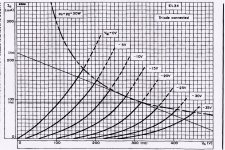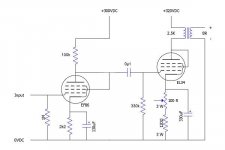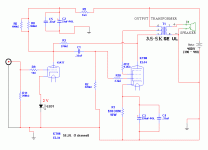Evening all,
I'm getting back into hi-fi after a few years of making do with whatever was to hand, but (I suspect) like a lot of us here my ears have expensive taste, whilst my pockets are relatively shallow. Thus, I've been compelled to dust off my brain cells and am planning a winter project to design and (hopefully ) build a single-ended triode amp.
) build a single-ended triode amp.
Money and availability of parts/accessories have forced a couple of design limitations:
- My current speakers are 8 ohm. Since I don't intend to replace them any time soon, I'm designing for an 8 ohm load.
- As a long time guitarist, I have a lot of spare valves commonly associated with guitar amps, including some NOS examples which caould be put to better use.
- I'm very new to all of this, so the circuit must be initially simple - firstly to increase my chances of making somethng that not only works but sounds good too, and so as not to over-stress my lazy brain cells, which I've been subduing with strong ale and wine .
.
- The amp itself needs to be physically quite small, as space is at a premium.
After dabbling with EL84s (both pentode and triode), I finally found a promising output stage using a triode strapped EL34, fed from an EF86 driver stage. Here's a tentative first go at a circuit:


I'm estimating 4.1W per channel, with 2.63% 2nd harmonic distortion. Feel free to laugh if my figures are way off, although when you're quite done I'd appreciate it if you could tell me where I've gone wrong .
.
Assuming it's not a complete non-starter, there are a couple of questions I'd appreciate some advice on, namely:
- Will the driver stage be powerful enough to drive the output?
- Will I need a seperate pre-amp to feed the driver?
I'm currently mostly listening to vinyl, through an old Project Phono Box MM, who's output is a suggested 500mV @1kHz.
I can show my working, if that'd help, but I won't ask you to check my errors just yet. Any more info you'd like to see I'll do my best to provide.
Thanks,
Matt.
-
I'm getting back into hi-fi after a few years of making do with whatever was to hand, but (I suspect) like a lot of us here my ears have expensive taste, whilst my pockets are relatively shallow. Thus, I've been compelled to dust off my brain cells and am planning a winter project to design and (hopefully
Money and availability of parts/accessories have forced a couple of design limitations:
- My current speakers are 8 ohm. Since I don't intend to replace them any time soon, I'm designing for an 8 ohm load.
- As a long time guitarist, I have a lot of spare valves commonly associated with guitar amps, including some NOS examples which caould be put to better use.
- I'm very new to all of this, so the circuit must be initially simple - firstly to increase my chances of making somethng that not only works but sounds good too, and so as not to over-stress my lazy brain cells, which I've been subduing with strong ale and wine
- The amp itself needs to be physically quite small, as space is at a premium.
After dabbling with EL84s (both pentode and triode), I finally found a promising output stage using a triode strapped EL34, fed from an EF86 driver stage. Here's a tentative first go at a circuit:


I'm estimating 4.1W per channel, with 2.63% 2nd harmonic distortion. Feel free to laugh if my figures are way off, although when you're quite done I'd appreciate it if you could tell me where I've gone wrong
Assuming it's not a complete non-starter, there are a couple of questions I'd appreciate some advice on, namely:
- Will the driver stage be powerful enough to drive the output?
- Will I need a seperate pre-amp to feed the driver?
I'm currently mostly listening to vinyl, through an old Project Phono Box MM, who's output is a suggested 500mV @1kHz.
I can show my working, if that'd help, but I won't ask you to check my errors just yet. Any more info you'd like to see I'll do my best to provide.
Thanks,
Matt.
-
- Will the driver stage be powerful enough to drive the output?
- Will I need a seperate pre-amp to feed the driver?
-
The EL34 is biased at 20V/94mA. If anything, the EF86 is way too sensitive to drive the EL34, especially wired as a pentode. Based on your phono preamp having 500mV of output (kinda low, but adequate), something like a 12AT7, 5965, 6DJ8, or 5670 will provide adequate but not over the top gain.
A 220 ohm cathode bias resistor should be just fine for what you're doing. A 5W part is probably adequate, but a 10W resistor will provide lots of thermal margin. I don't think it would hurt to go to a 470uF bypass cap on the output stage.
I like the suggestions to triode strap the EF86 if you find it too noisy or too sensitive as is. That's an easy change, so I say build it as you drew it out and then tweak it to hear the difference first hand.
FWIW, I like the EL34 as a single ended output stage. I have such an amp with a 5965 driver and it's very musical.
FWIW, I like the EL34 as a single ended output stage. I have such an amp with a 5965 driver and it's very musical.
Various threads here on this topic.
For Example:
Simple EL34 SET; advice?
Many suggestions in that thread including this one:
Tubelab SSE | Tubelab
Cheers,
Ian
For Example:
Simple EL34 SET; advice?
Many suggestions in that thread including this one:
Tubelab SSE | Tubelab
Cheers,
Ian
The EL34 is biased at 20V/94mA. If anything, the EF86 is way too sensitive to drive the EL34, especially wired as a pentode. Based on your phono preamp having 500mV of output (kinda low, but adequate), something like a 12AT7, 5965, 6DJ8, or 5670 will provide adequate but not over the top gain.
A 220 ohm cathode bias resistor should be just fine for what you're doing. A 5W part is probably adequate, but a 10W resistor will provide lots of thermal margin. I don't think it would hurt to go to a 470uF bypass cap on the output stage.
Thanks for the advice. I was worried the EF86 wouldn't be powerful enough, turns out I'd gone too far the other way! Oh well, back to the drawing board. Would you suggest using the EF86 as a triode (as Ketje ably illustrates below), or opting for something different?
What about the 12AT7 (or ECC81, in Brit speak
Re the output cathode bias, if memory srves I was aiming for a 1Hz cut off frequency with the 130uF cap. Assuming I've got my calculations correct (which I may well have not), changing up to a 470uF is presumably going to raise that frequency? Is designing for 1Hz overkill in this situation? I'm learning most of what I know from Morgan Jones 'Designing Valve Amplifiers'. He certainly recomends a 1Hz cut off in small signal stages, does that concept not transfer to the output stage?
Matt.
Try someting like this.
Mona
Thank you, I'll give that some serious consideraion. One question - what effect will the change of value in the grid stopper resistor from 1M to 330K have?
Is it there to increase the gain or alter the input impedence?
Just one more thing (doing my best Columbo impression), is 0u1 the same as 0.1uF? I don't think I've seeen it written that way before.
Matt.
Various threads here on this topic.
For Example:
Simple EL34 SET; advice?
Many suggestions in that thread including this one:
Tubelab SSE | Tubelab
Cheers,
Ian
Thanks for the links. I've been browsing several of these threads and garnering what information I can understand - there's a lot to take in!
Given my build is designed from the ground up, I thought I might risk a new thread to ask some specific advice about the circuit I've designed. Reinventing the wheel, to be sure, but it'll keep me busy on the dark winter nights. Assuming I'm not at the pub
Matt.
I don't think it would hurt to go to a 470uF bypass cap on the output stage.
Just re-read the section by Mr Jones on power amp design. 1Hz is indeed a bad choice for a power amp, I'll take your advice and investigate some different values. Or more likely just change the value to 470uF...
Matt.
ght:250px" tabindex="1" dir="ltr">
Mullard specifies 500k as a max. , with 330k we are on the safe side.
Is like 2,2kΩ writen as 2k2.
Mona
It's not a stopper, but a path to ground for the grid to get it on zero voltage.Thank you, I'll give that some serious consideraion. One question - what effect will the change of value in the grid stopper resistor from 1M to 330K have?
Is it there to increase the gain or alter the input impedence?
Mullard specifies 500k as a max. , with 330k we are on the safe side.
Yes same thing. 100nF or 0,1µF or 0µ1Just one more thing (doing my best Columbo impression), is 0u1 the same as 0.1uF? I don't think I've seeen it written that way before.
Is like 2,2kΩ writen as 2k2.
Mona
ght:250px" tabindex="1" dir="ltr"> It's not a stopper, but a path to ground for the grid to get it on zero voltage.
Mullard specifies 500k as a max. , with 330k we are on the safe side.
Mona
Thanks. I think I meant to say grid leak, but thanks for the explanation. Although it seems obvious now, I hadn't realised it was performing that function. I thought it just served as a path to ground for stray electrons which found themselves attracted to the grid, on thier way to the anode.
Matt.
Hello,
Post #12 here is for an easy and good sounding build.
Good schematic for SE EL34/KT88 amp | Audiokarma Home Audio Stereo Discussion Forums
Post #12 here is for an easy and good sounding build.
Good schematic for SE EL34/KT88 amp | Audiokarma Home Audio Stereo Discussion Forums
Attachments
Hello,
Post #12 here is for an easy and good sounding build.
Good schematic for SE EL34/KT88 amp | Audiokarma Home Audio Stereo Discussion Forums
Hi,
Thanks for the link, but having gone to the trouble of designing my own circuit, I'm at least going to give it the honour of a fair trial.
Matt.
If you need more power for your speakers, consider a pentode output stage, but use the EF86 in pentode with some (plate-to-plate?) feedback.
One of my favorite amps was an EL156 (later 6550s) in Ultralinear driven by a EF86 in pentode. Loop feedback was used.
I had worried that 4W might not be enough to drive my current speakers. I made some enquiries to that effect in the speakers forum last week, and the general consensus was that whilst the frequency response may need tailoring, they'd be efficient enough to be driven from a mere 4W.
I also designed a circuit using the EL84 as a pentode, which put out a litle more power (around 6W), but I wasn't happy with my calculations for the screen grid voltage/current.
There also seems to be a certain positive opinion about SE triode amps more generally. Whether this is hype, fashion or b/s I won't pretend to know, but given the relative simplicity of a triode stage, I'm willing to buy into it, for now
Matt.
The real Problem with EF86 pentode input is that the gain is much too high for any modern Pentode output to drive. Look at the old Mullard circuits, they have much less input voltage. Same with the Klangfilm. EF86 is intended to be used as an instrument amplifier tube with exceptional high gain or as phono preamp tube. There you can use that lot of gain. In an amp that needs only 8-15V to drive the output tube and a high input source voltage youll end up with a hard negative feedback circuit like all the last generation studio amps that used this tube. So your sound will be over-analytic with very low distortions (as the studio equipment was intended for), but hard sounding without any swing.
Last edited:
A triode strapped EF86 will work well, but they are a fairly expensive tube to use for such use.
The 12AT7 is a good choice. A 12AU7 with the output of your phono stage will fall a little short. (Though to be fair, you should post your cartridge output voltage and phono preamp gain)
The 12AT7 is a good choice. A 12AU7 with the output of your phono stage will fall a little short. (Though to be fair, you should post your cartridge output voltage and phono preamp gain)
A triode strapped EF86 will work well, but they are a fairly expensive tube to use for such use.
The 12AT7 is a good choice. A 12AU7 with the output of your phono stage will fall a little short. (Though to be fair, you should post your cartridge output voltage and phono preamp gain)
The EF86 is indeed comparatively expensive, but has the advantage of being a valve I already have a small stockpile of. I suppose this is a short sighted outlook, as valves don't last forever although I'd estimate under normal usage I'll get a good few years from my supply before I need to replace them.
I've been playing around with some loadlines this afternoon, trying out the 12AT7 vs. the EF86 as a triode, but I haven't settled on a preference as yet.
A quick question - the 12AT7 is a dual triode, is it not? Could I use one half of the valve to drive the left channel and the other to drive the right, or would I be asking for trouble doing it that way?
I'm using an Ortofon VMS20 MkII, which puts out 5mV. The phono stage has a stated gain of 40 dB.
Matt.
One half of the 12at7 for each channel is how it's been done 1000's of times.
Cool. Apologies for asking daft questions but I'm fairly new to this. Experience tells me you end up looking a bigger fool having not asked a stupid question, and cocked things up, than you do if you take the plunge and ask
I was worried there might be some issues with cross talk between channels or any number of cruel and unusual tricks of the electron I'm yet to encounter.
Being able to drive both channels from a single bottle definitely swings the advantage in favour of the ECC81.
Matt.
Last edited:
- Status
- This old topic is closed. If you want to reopen this topic, contact a moderator using the "Report Post" button.
- Home
- Amplifiers
- Tubes / Valves
- Designing a Single-Ended Triode EL34 Power Amp

